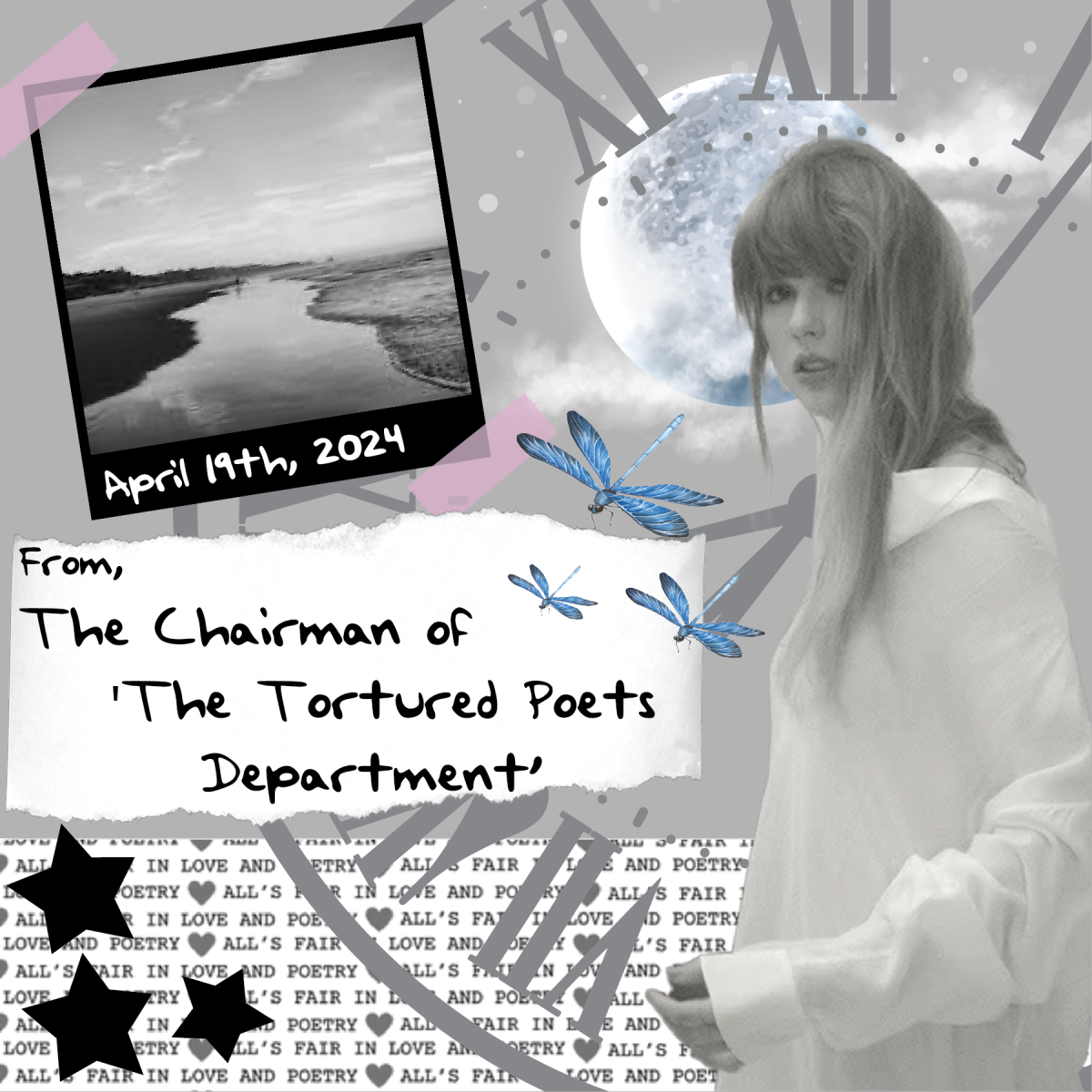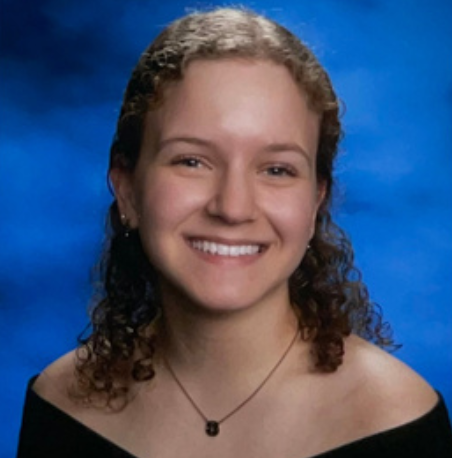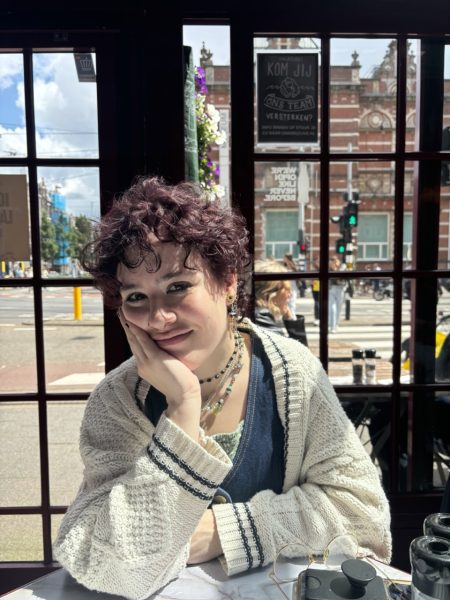“The Tortured Poets Department” leaves listeners waiting for more
Meg Frantz
As the self-proclaimed chairman of the Tortured Poets Department, Taylor Swift dives into past relationships with a quill pen poised to be a viper.
“The Tortured Poets Department,” Swift’s newest album, was released with 16 tracks on April 19 at midnight, but a surprise 15 additional tracks were released at 2 am. The 31 songs together are more akin to mundane diary poetry than artful literature. With almost a week post-release to digest this hefty collection, let’s dive in.
The album opener, “Fortnight,” features Post Malone in a call-and-response format set to a syncopated synth base and layered vocals. The melodic track holds back on production and saves room for the lyricism for which Swift is known. The repetitive “And I love you, it’s ruining my life / I love you, it’s ruining my life” sets the tone for the rest of the album, and Malone takes over the outro, with mentions of Florida rife throughout the album.
“Fortnight” is also the only song thus far to have a music video, featuring Ethan Hawke and Josh Charles, who played Todd Anderson and Knox Overstreet respectively in the 1989 movie “Dead Poets Society.” In the music video, they play the role of scientists who experiment on Swift. In a play on words, Swift said in an Instagram post, “Tortured poets, meet your colleagues from down the hall, the dead poets.”
Following the theme of the deep south, “Florida!!!” features Florence + The Machine and deviates from the melodic tone with deep crashing drums. The song, with the chorus “Florida / Is one hell of a drug / Florida / Can I use you up?” makes various references to white-collar crime and using Florida as an escape from consequences. Florence Welch, a songwriter and performer on the track, follows this theme with the lines “All my girls got their lace and their crimes / And your cheating husband disappeared, well / No one asks any questions here.”
The 10th track, “Who’s Afraid of Little Old Me?” is an ode to “Reputation,” Swift’s sixth album. A cinematic portrayal of the media interpretation of Swift from country princess to conniving schemer, the track asks for a questioning of her reputation but simultaneously affirms it with the lines, “So I lеap from the gallows and I levitate down your street / Crash the party like a record scratch as I scream / ‘Who’s afraid of little old me?’ / I was tame, I was gentle ‘til the circus life made me mean.”
Swift simulates this pattern of harping against and affirming her reputation throughout the album, creating confusion for listeners as to what they should believe of her.
To close the original 16 songs released at midnight, “Clara Bow” calls to the stage women in history “picked like a rose.” Mentioning Clara Bow, an actress in the age of the transition from silent films to “talkies” and the first “it-girl,” Swift alludes to mental health issues due to the stress of fame. Quickly after, Swift mentions Stevie Nicks, one of 1975’s icons who ruled the stage almost as if she were magical. Finally, Swift name-drops, placing herself among the it-girls of history. However, riddled throughout the track is commentary on the cost of being dazzling, and in the bridge, she sings, “Only when your girlish glow flickers just so / Do they let you know / It’s hell on earth to be heavenly.”
The rest of the songs lean toward the melodic tone set by “Fortnight” to Swift’s demise. In an effort to be reflective, it instead comes across as mundane and repetitive, particularly in the musical aspects.
During promotional efforts for the album, a pop-up “library” at The Grove in Los Angeles was set with various odes to the number two. Featuring a stone peace-sign statue, two candlesticks, a clock set to 2:00 and two sheets of lyrics, fans speculated that “The Tortured Poets Department” could be a double-album release … their wish was Swift’s command.
At 2 a.m. on April 19, “The Tortured Poets Department: The Anthology” was released.
Swift wrote a majority of “The Anthology” with Aaron Dessner, while Jack Antonoff had a majority of songwriting credits on the original 15 tracks. This created a divide between the original release and the following drop with a clear distinction between Dessner’s pen and Antonoff’s.
“The Albatross,” whose chorus says “Cross your thoughtless heart / Only liquor anoints you / She’s the albatross / She is here to destroy you,” plays with the fine line between good and evil. References to “The Rime of the Ancient Mariner” by Samuel Taylor Coleridge bring to light the bad omen that comes with killing a symbol of innocence. In this allusion, Swift paints herself and other women as the albatross and men as the ones who release the arrow.
The song “thanK you aIMee,” capitalized to spell out “Kim” — as in Kim Kardashian — is a supposed diss track toward Kardashian and Kanye West, with whom Swift has had a long-running rocky relationship. The song is in response to the 2009 VMA drama, wherein West interrupted Swift’s acceptance speech and said that Beyonce should have won, Kardashian defended West.
This track, with the chorus “Screamed, ‘F–K you, aIMee’ to the night sky as the blood was gushin’ / But I can’t forget the way you made me heal,” points to the situation and Swift’s grudge that fueled her actions following. While not remarkable musically, the drama behind the track makes up for it.
To close “The Anthology” is “The Manuscript,” a slow piano ballad where she reflects on the relationships on blast throughout the album. With lines “Lookin’ backwards / Might be the only way to move forward” and “Now and then I reread the manuscript / But the story isn’t mine anymore,” the song is melancholic and simplistic, leaving this portion of Swift’s life behind her.
Save seven standouts, the rest of the two combined albums leave listeners bored, as musically most of the tracks sound similar and lyrically there is not much distinction between songs. The only thing that saves it is Swift’s complex world, which allows for deep analysis on fans’ behalf.
Regardless of the juvenile lyricism — note “We declared Charlie Puth should be a bigger artist” in the title track — all’s fair in love and poetry.
“The Tortured Poets Department” is for Swift, not Swifties
Leah Boone
On April 19, Taylor Swift once again outdid herself, this time perhaps more than ever.
“The Tortured Poets Department” broke multiple records, including most Spotify streams in a single day. The original album was released at midnight with 16 songs; subsequently, as many Swifties predicted, a surprise double album release occurred. “The Tortured Poets Department: The Anthology” was dropped at 2 a.m. with an additional 15 songs.
Throughout the double album, it becomes increasingly evident that Swift wrote this record for her own cathartic reasons, not to impress the fans.
With a total of 31 songs, Swift broke the hearts of her fans while simultaneously providing a multitude of upbeat songs to dance to, some of which being one in the same. “I Can Do It With a Broken Heart” describes Swift continuing the Eras Tour directly after a breakup with her boyfriend of six years, Joe Alwyn, but does so in an extremely upbeat manner.
The chorus lyrics, “Lights, camera, b—h smile, even when you wanna die / he said he’d love me all his life / but that life was too short / breaking down, I hit the floor / all the pieces of me shattered as the crowd was chanting ‘more’” are arguably some of the saddest on the album, but delivered in such a cheery tone that it is difficult to interpret the full depth of them.
Many fans were disappointed by the album, claiming the songs sound similar to each other or ones from previous albums and some of the lyrics were laughable at best. While some of the songs do give off the same vibe, each is a unique deep dive into Swift’s innermost thoughts and feelings. She wrote this album as a diary and as a way to cope with the heartbreak, trauma, anger and newfound love she has felt over the last few years.
Swift shared this sentiment herself during The Eras Tour, saying “It was really a lifeline for me, just the things I was going through, the things I was writing about.”
Two of the most evident examples of this are “How Did It End?” and “So Long, London.” It is not a coincidence that both of these are the fifth track of their respective albums, which are notoriously known as the saddest tracks on each album. Both track fives on Swift’s latest record are easily her saddest in history.
“So Long, London” is a song that needs no interpretation, as it very clearly mourns Swift’s relationship with Alwyn. With lyrics such as “And you say I abandoned the ship / but I was going down with it / my white knuckle dying grip / holding tight to your quiet resentment” and “And I’m just getting color back into my face / I’m just mad as hell cause I loved this place,” she breaks the hearts of everyone who has ever endured the ending of a relationship.
Swift is no stranger to truly heart-wrenching songs and “How Did It End?” is no exception to the rule. The song depicts the rumors of a breakup circulating through a town, and each bystander wanting to know why the couple broke up, being made evident by the chorus lyrics, “It’s happening again / the empathetic hunger descends / we’ll tell no one except all of our friends.”
The bridge of “How Did It End?” is the icing on top of an already devastating song, as many of Swift’s bridges are. Her lyrics “Say it once again with feeling / how the death rattle breathing / silenced as the soul was leaving / the deflation of our dreaming / leaving me bereft and reeling” use imagery to break the hearts of every listener.
This, however, was not enough for Swift, as the remainder of the bridge is easily some of the most agonizing lyrics she has ever written. Playing on a well-known children’s nursery rhyme, Swift sings “My beloved ghost and me / sitting in a tree / D-Y-I-N-G.” Cut the cameras — nobody wants to see ugly crying with every stream of the song.
Though these two are easily the best songs on the album, there are certainly many more standouts — “Who’s Afraid of Little Old Me?”, “loml,” “imgonnagetyouback” and “Cassandra” each add a unique perspective to the album.
“The Alchemy” and “So High School,” the most evident songs about Swift’s new beau, Travis Kelce, are filled with football metaphors, cheesy jokes and consistent affirmations of how in love she is.
There are also a few references to previous albums or songs, one of the most notable being the intro of “So Long, London” sounding remarkably similar to that of “Call It What You Want” from “Reputation.” For those who have seen Swift’s documentary, the similarity between these two songs brings a whole new level of sadness to Swift’s latest track five.
Though a lot of Swift’s songs seem deeply personal, “The Tortured Poets Department” creates a new definition for the word. Listeners feel as if they are reading directly from her diary, making the album elicit even stronger emotions than usual.
It may not be everyone’s favorite album, but one cannot argue it is both a lyrical masterpiece and an intimate look into Swift’s personal life. “The Tortured Poets Department” was made by Swift for Swift, and fans simply have the privilege of listening to it.
With Swift having been creating music for almost 20 years, it is hard to believe that she still has tricks up her sleeve. However, if there is one thing that fans have learned over the years, it is to never doubt the chair of the Tortured Poets Department.




